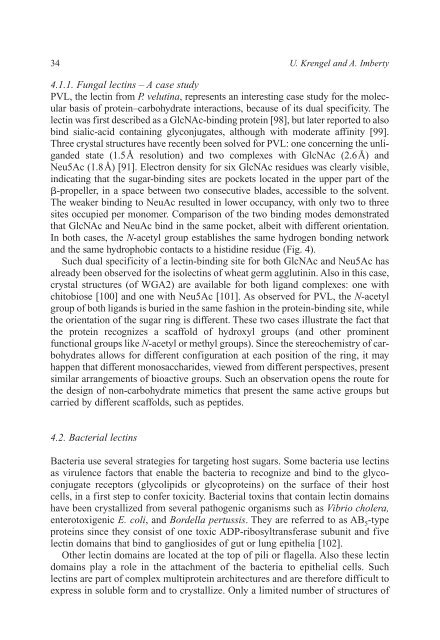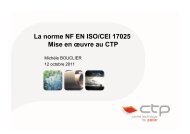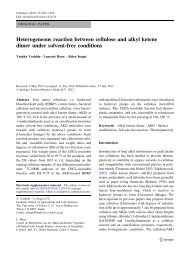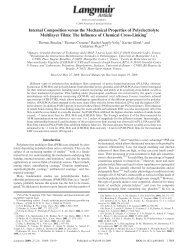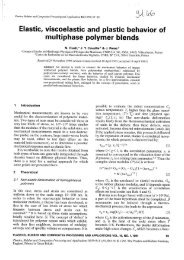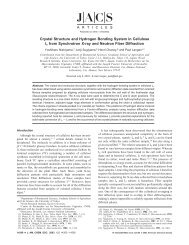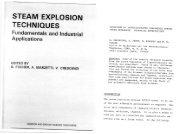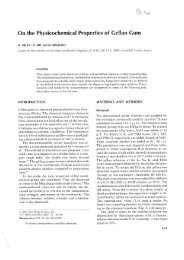Crystallography and Lectin Structure Database - CNRS
Crystallography and Lectin Structure Database - CNRS
Crystallography and Lectin Structure Database - CNRS
Create successful ePaper yourself
Turn your PDF publications into a flip-book with our unique Google optimized e-Paper software.
34 U. Krengel <strong>and</strong> A. Imberty<br />
4.1.1. Fungal lectins – A case study<br />
PVL, the lectin from P. velutina, represents an interesting case study for the molecular<br />
basis of protein–carbohydrate interactions, because of its dual specificity. The<br />
lectin was first described as a GlcNAc-binding protein [98], but later reported to also<br />
bind sialic-acid containing glyconjugates, although with moderate affinity [99].<br />
Three crystal structures have recently been solved for PVL: one concerning the unlig<strong>and</strong>ed<br />
state (1.5Å resolution) <strong>and</strong> two complexes with GlcNAc (2.6Å) <strong>and</strong><br />
Neu5Ac (1.8Å) [91]. Electron density for six GlcNAc residues was clearly visible,<br />
indicating that the sugar-binding sites are pockets located in the upper part of the<br />
-propeller, in a space between two consecutive blades, accessible to the solvent.<br />
The weaker binding to NeuAc resulted in lower occupancy, with only two to three<br />
sites occupied per monomer. Comparison of the two binding modes demonstrated<br />
that GlcNAc <strong>and</strong> NeuAc bind in the same pocket, albeit with different orientation.<br />
In both cases, the N-acetyl group establishes the same hydrogen bonding network<br />
<strong>and</strong> the same hydrophobic contacts to a histidine residue (Fig. 4).<br />
Such dual specificity of a lectin-binding site for both GlcNAc <strong>and</strong> Neu5Ac has<br />
already been observed for the isolectins of wheat germ agglutinin. Also in this case,<br />
crystal structures (of WGA2) are available for both lig<strong>and</strong> complexes: one with<br />
chitobiose [100] <strong>and</strong> one with Neu5Ac [101]. As observed for PVL, the N-acetyl<br />
group of both lig<strong>and</strong>s is buried in the same fashion in the protein-binding site, while<br />
the orientation of the sugar ring is different. These two cases illustrate the fact that<br />
the protein recognizes a scaffold of hydroxyl groups (<strong>and</strong> other prominent<br />
functional groups like N-acetyl or methyl groups). Since the stereochemistry of carbohydrates<br />
allows for different configuration at each position of the ring, it may<br />
happen that different monosaccharides, viewed from different perspectives, present<br />
similar arrangements of bioactive groups. Such an observation opens the route for<br />
the design of non-carbohydrate mimetics that present the same active groups but<br />
carried by different scaffolds, such as peptides.<br />
4.2. Bacterial lectins<br />
Bacteria use several strategies for targeting host sugars. Some bacteria use lectins<br />
as virulence factors that enable the bacteria to recognize <strong>and</strong> bind to the glycoconjugate<br />
receptors (glycolipids or glycoproteins) on the surface of their host<br />
cells, in a first step to confer toxicity. Bacterial toxins that contain lectin domains<br />
have been crystallized from several pathogenic organisms such as Vibrio cholera,<br />
enterotoxigenic E. coli, <strong>and</strong> Bordella pertussis. They are referred to as AB 5 -type<br />
proteins since they consist of one toxic ADP-ribosyltransferase subunit <strong>and</strong> five<br />
lectin domains that bind to gangliosides of gut or lung epithelia [102].<br />
Other lectin domains are located at the top of pili or flagella. Also these lectin<br />
domains play a role in the attachment of the bacteria to epithelial cells. Such<br />
lectins are part of complex multiprotein architectures <strong>and</strong> are therefore difficult to<br />
express in soluble form <strong>and</strong> to crystallize. Only a limited number of structures of


